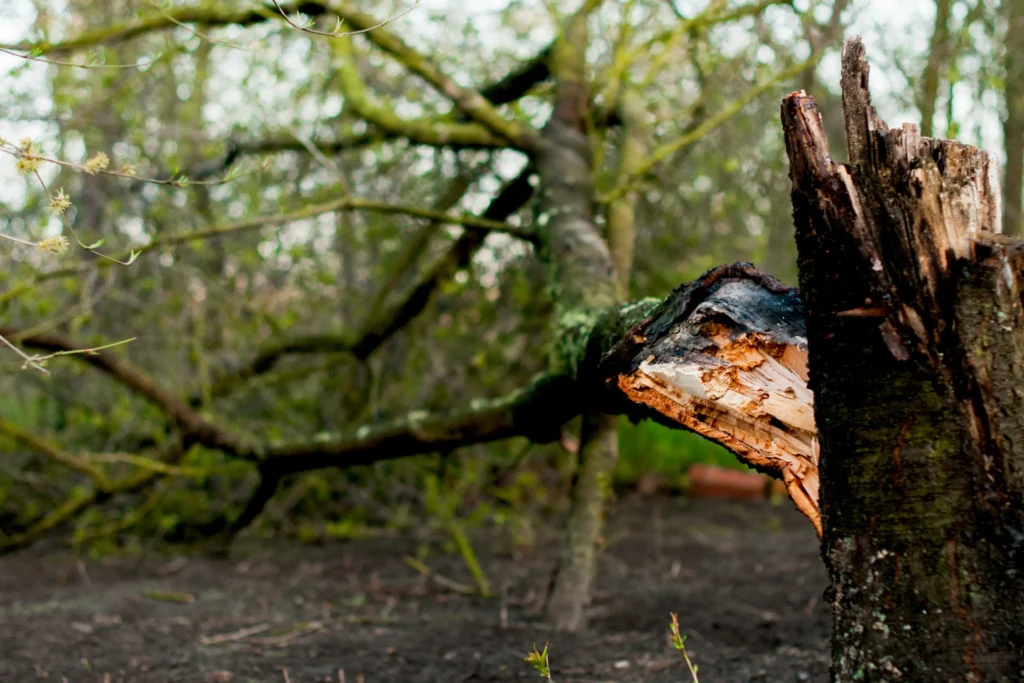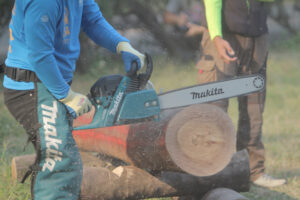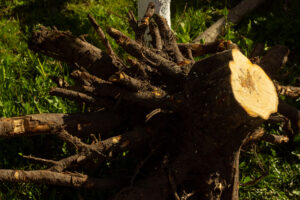Keeping your house secure from storm damage caused by fallen trees helps to maintain its structural soundness and safety.
Storms can turn even healthy trees into possible dangers, putting people, automobiles, and buildings at risk.
Determining potential risks and pursuing preventative strategies that mitigate these occurrences can greatly lower the possibility of damage.
This article will cover a variety of preventive strategies to keep your house and the surrounding trees in good condition.
You can lessen the need for expensive repairs and be better prepared for bad weather by being knowledgeable and following the best practices.
1. Inspect Surrounding Trees

A broken tree branch can cause damage
A physical inspection is crucial in detecting possible threats like dead or weakening branches, illnesses, or unstable root systems. Regular inspections might uncover flaws that could cause a tree to collapse or drop huge branches during a storm. Addressing these concerns proactively allows you to take remedial activities such as trimming or removing at-risk trees, decreasing the possibility of costly damage to your property and guaranteeing occupants’ safety.
2. Tree Health Maintenance
Regular care keeps trees structurally strong, lowering the chance of limbs or entire trees collapsing during a storm. Pruning helps to remove weak or unhealthy branches that may fall off and cause damage. Furthermore, good maintenance improves the general health of trees, making them more resistant to unfavorable weather conditions. By investing in tree health management, homeowners reduce the chance of property damage, ensure safety, and preserve the aesthetic value of their environment.
3. Structural Support
Trees, particularly during storms, provide considerable threats such as falling branches or full uprooting. Adequate structural support, such as strong building materials and well-maintained roofs, helps to limit these dangers by lowering the effect of falling debris and avoiding structural collapse. Furthermore, effective structural support guarantees that buildings can resist the pressures applied by severe winds or heavy rainfall, safeguarding occupants while reducing costly repairs and disturbances to everyday life.
4. Property Preparation
Loose things can become dangerous during strong winds or storms, perhaps smashing windows and inflicting further damage. Reinforcing windows with shutters or impact-resistant glass prevents them from shattering, preserving the building’s integrity and protecting its inhabitants. These precautionary steps considerably minimize the danger of damage, making the property better prepared to resist the pressures of a storm.
5. Insurance Coverage
Comprehensive insurance coverage provides financial protection against the costly repairs or replacements caused by fallen trees or branches. This coverage means that homeowners may recover quickly without taking on the entire financial load alone, providing peace of mind and stability during a disruptive and stressful period. By reducing the financial risks connected with storm damage, insurance helps homeowners concentrate on recovery and rebuilding rather than worrying about the financial consequences of such unanticipated disasters.
6. Planting Location
Positioning trees away from houses, electrical lines, and frequently traveled areas decreases the likelihood of limbs or the entire tree falling during storms, hence reducing possible property damage and personal harm. Proper spacing between trees and structures prevents roots from undermining foundations or utilities, hence ensuring structural integrity. Strategic placement also takes into account the tree type and its development capacity, which improves resilience to severe winds and heavy rains. This improves both landscape safety and infrastructure durability.
Reasons to Hire an Expert
Although trees give beauty and shade, they may also represent a serious risk during a storm. Fortunately, a professional arborist can greatly lessen the likelihood of storm-related damage to your home. Weak branches, impacted sections, or trees with inadequate root systems are all potential dangers during heavy winds and should be included in a risk assessment of adjacent trees. With this knowledge, experts may prescribe careful cutting to enhance the tree’s structure and reduce wind resistance. In some cases, additional support may need techniques like bracing and cabling. By proactively addressing these problems, an arborist can help your trees withstand the storm while also protecting your home from unexpected damage.
It is essential to take preventive actions to protect your home from storm damage caused by trees. Following these procedures allows homeowners to avoid possible dangers. Regularly checking trees for symptoms of illness or instability allows for timely action. Pruning branches away from buildings can help to reduce the danger of damage during storms. Furthermore, the risk of damage is reduced by carefully placing trees far from buildings. Implementing these procedures creates a safer environment, protects property, and increases overall resistance to natural catastrophes.




